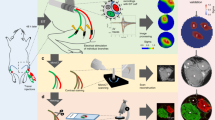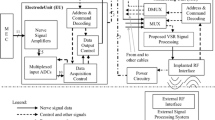Abstract
Impedance changes were measured during the compound action potential (CAP) in isolated crab nerves with 50 kHz or direct applied current (DC), to suggest an optimal frequency for the imaging of neuronal depolarisation by electrical impedance tomography (EIT). With DC, a predominant apparent impedance decrease of 0.2–0.7 per cent of the resting baseline was observed, which had a time course similar to that of the action potential. Control recordings suggested that these changes could not be attributed to technical errors resulting from the measurement method. A component in some measurements was attributable to effects of the measuring current on the latency of the CAP, but the mechanism underlying the remainder of the changes was unclear. No changes greater than ±0.005 per cent were seen with measurement at 50 kHz. This suggests that research into noninvasive rapid imaging of nervous activity in the brain with EIT would be more profitably performed with measurements at frequencies lower than the 50 kHz currently used for safety reasons.
Similar content being viewed by others
References
Barber, D. C. andBrown, B. H. (1984) Applied potential tomography.J. Phys. E: Sci. Instrum.,17, 723–733.
Barrett, E. F. andBarrett, J. N. (1982) Intracellular recording from vertebrate myelinated axons: mechanism of the depolarizing afterpotential.J. Physiol.,323, 117–144.
Brown, B. H. (1983) Tissue impedance methods. InImaging with non-ionizing radiations.Jackson, D. F. (Ed.), Surrey University Press, 85–110.
Brown, B. H., Barber, D. C. andSeagar, A. D. (1985) Applied potential tomography: possible clinical applications.Clin. Phys. & Physiol. Meas.,6, 109–121.
Brown, B. H. andSeagar, A. D. (1987) The Sheffield data collection system.,8, Suppl. A, 91–98.
Chailakhian, L. M. andIur'ev, S. A. (1957) An investigation of the time relations of the action potential and impedance changes on excitation in the frog nerve.Biofizika,2, 417–426.
Cole, K. S. andCurtis, H. J. (1939) Electric impedance of the squid giant axon during activity.J. Gen. Physiol.,22, 649–670.
Eisenberg, R. S. andJohnson, E. A. (1970) Three-dimensional field problems in physiology.Progr. Biophys. Molec. Biol.,20, 1–65.
Freygang, W. H. andLandau, W. M. (1955) Some relations between resistivity and electrical activity in the cerebral cortex of the cat.J. Cell. Comp. Physiol.,45, 377–392.
Hodgkin, A. L. (1939) The relation between conduction velocity and the electrical resistance outside a nerve fibre.J. Physiol.,94, 560–570.
Hodgkin, A. L. (1947) The membrane resistance of a non-medullated nerve fibre.,106, 305–318.
Holder, D. S. (1987) Feasibility of developing a method of imaging neuronal activity in the human brain: a theoretical review.Med. & Biol. Eng. & Comput.,25, 2–11.
Holder, D. S. andGardner-Medwin, A. R. (1988) Some possible neurological applications of applied potential tomography.Clin. Phys. & Physiol. Meas.,9, Suppl. A, 111–119.
Holder, D. S. (1989) Impedance changes during evoked nervous activity in human subjects: implications for the application of applied potential tomography (APT) to imaging neuronal discharge.,10, 267–274.
Julian, F. J., Moore, J. W. andGoldman, D. E. (1962) Membrane potentials of the lobster giant axon obtained by use of the sucrose-gap technique.J. Gen. Physiol.,45, 1195–11216.
Katz, B. (1948) The electric properties of the muscle fibre membrane.Proc. R. Soc. Lond. B,135, 506–534.
Keynes, R. D. andLewis, P. R. (1951) The resting exchange of radioactive potassium in crab nerve.J. Physiol.,113, 73–98.
Klivington, K. A. andGalambos R. (1968) Rapid resistance shifts in cat cortex during click-evoked responses.J. Neurophysiol.,31, 565–573.
Kocsis, J. D., Malenka, R. C. andWaxman, S. G. (1983) Effects of extracellular potassium concentration on the excitability of the parallel fibres of the rat cerebellum.J. Physiol.,334, 225–244.
van Harreveld, A. andOchs, S. (1956) Cerebral impedance changes after circulatory arrest.Am. J. Physiol.,187, 180–192.
Webster, J. G. (Ed.) (1990)Electrical impedance tomography. Adam Hilger, Bristol, UK.
Author information
Authors and Affiliations
Rights and permissions
About this article
Cite this article
Holder, D.S. Impedance changes during the compound nerve action potential: Implications for impedance imaging of neuronal depolarisation in the brain. Med. Biol. Eng. Comput. 30, 140–146 (1992). https://doi.org/10.1007/BF02446122
Received:
Accepted:
Issue Date:
DOI: https://doi.org/10.1007/BF02446122




